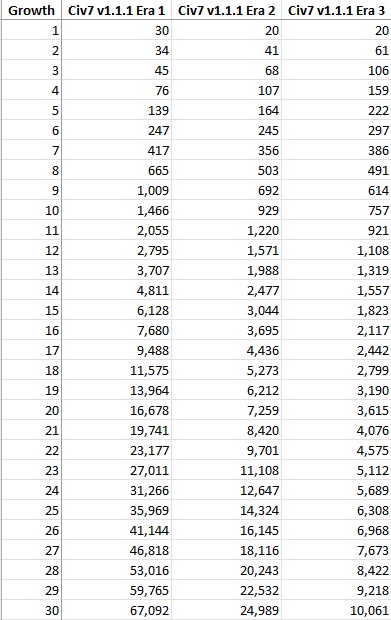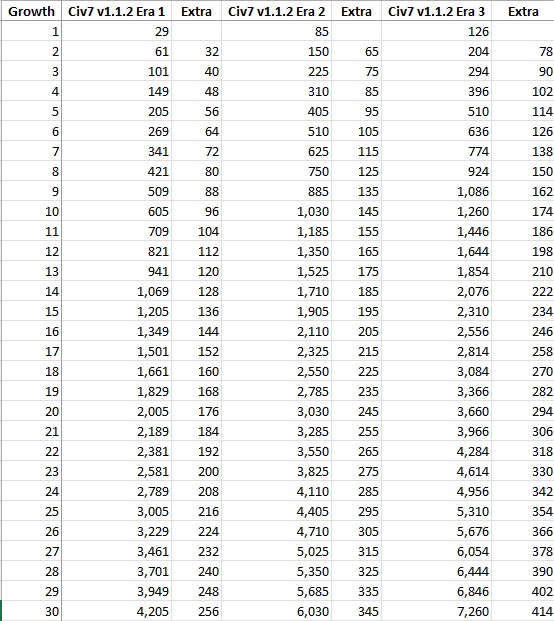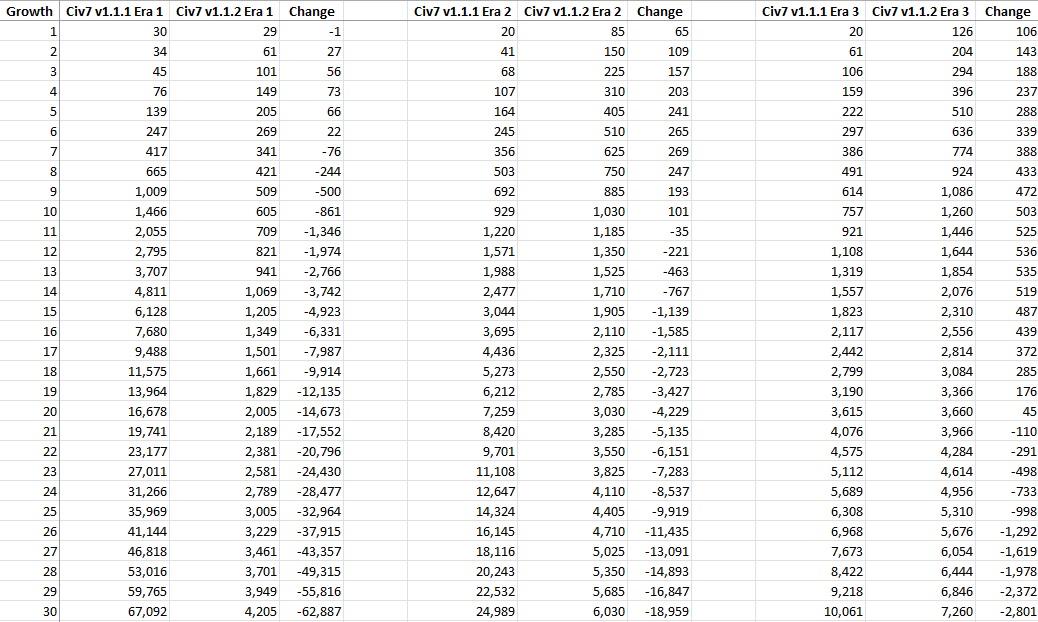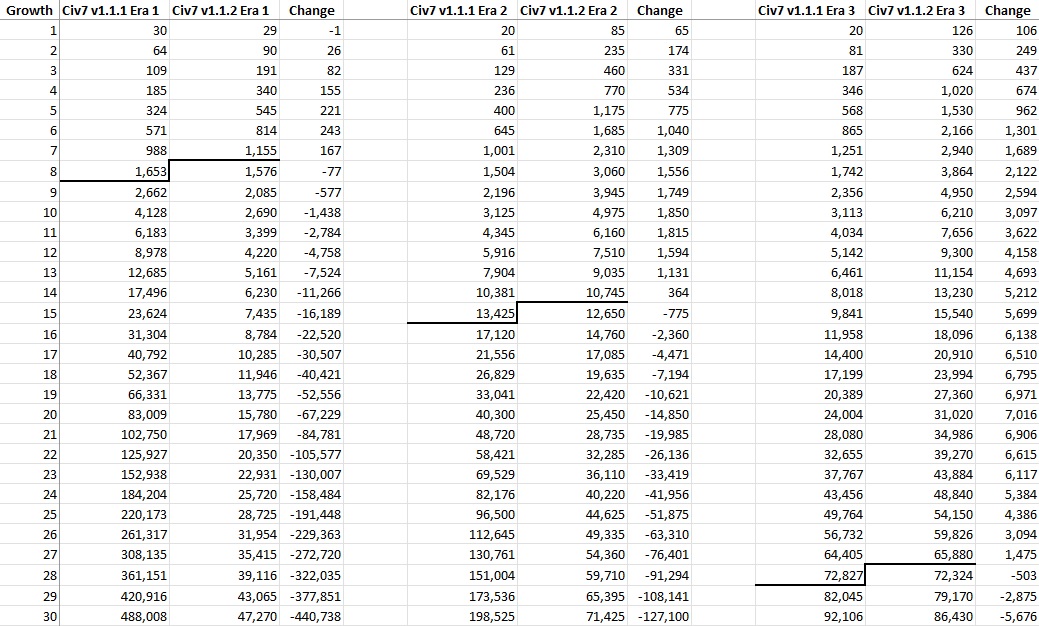Sullla
Patrician Roman Dictator
I know that there was another thread on the updated growth formula for Civ7's 1.1.2 patch but I've been experimenting with some of the numbers and I wanted to share the results with the community without getting buried on the second or third page. First of all, let's cover what the old growth formula looked like in the 1.1.1 and earlier patch versions of Civ7. The formula was based on an exponential calculation:
Where X is the number of growth events that have taken place thus far; note that this is *NOT* the population count that goes up from adding buildings. Only growth events that occur from filling up the food box count towards this number. The Flat, Scalar, and Exponent variables each had different values depending on the era that looked like this:
Flat Scalar Exponent
Era 1 30 3 33
Era 2 20 20 30
Era 3 20 40 27
With the biggest contributor to the formula being that big, fat exponent at the end. Even with the value being divided by 10, anyone with a math background can tell you that raising a sequence of numbers to the third power is going to cause the values to increase drastically over time. That's very much what happened under the old math which quickly exploded to ludicrous results:

If you look at the Ancient era column to start, it's clear that the growth targets start out reasonable before going absolutely crazy around the seventh or eighth time that the food box fills up. Cities start needing 1000 food to grow, then multiple thousands of food to grow, and by the 20th growth cities are needing TENS OF THOUSANDS of food to get the next population point. Things were a little bit better in the Exploration age but still spiraled out of control after a dozen or so growths. After all, even a city making 200 food/turn was looking at needing 20-30 turns for the next growth which was silly given that the whole Exploration age typically lasts 70-90 turns. It was only in the Modern era that cities could actually start growing thanks to a combination of several factors: food yields increasing across the board, buildings / fish factories decreasing the food needed per growth, and finally the growth formula itself changing to require vastly less food in the final era. This is the only time that I can recall mature cities growing at a regular pace under the previous patch.
Obviously the old growth formula had a lot of negative effects on gameplay. By making growth nearly impossible after the first few handful of times the food box filled up, food itself became practically useless as a yield. This made a vast array of buildings, civics, leaders, and civilizations almost pointless while also encouraging the "turn every town into a city" gameplay because all of the stuff that towns were supposed to do was neutered by the growth formula. Will things get better under the new patch? It's hard to say but the numbers are certainly different. This is the new formula:
Most of the formula looks the same, including Flat and Scalar and Exponent variables. The big difference is located in the last part of the formula, where the number of pop growths is now always squared instead of getting raised to the power of 3.3 / 3 / 2.7 across the different eras. This means that the scaling cost of additional pop growths is always going to be less in the long run because the calculation is working off a lower exponential power. The developers have offset this by increasing the food cost of the initial growths; more on this in a minute. The values of the Flat, Scalar, and Exponent variables are also now different:
Flat Scalar Exponent
Era 1 5 20 4
Era 2 30 50 5
Era 3 60 60 6
So what does all that mean in practice? Let's put the new growth numbers into a table:

I added a column indicating how much additional food is required for each growth which lines up very neatly. The second growth requires 32 more food than the first growth in the Ancient era, then 40 more food, then 48 more food, and so on endlessly. The following eras do basically the same thing at a slightly higher scaling rate, going up by 10 more food per growth in the Exploration age and 12 more food per growth in the Modern era. The math looks much more elegant than the mess that was the old growth formula (aside from someone at Firaxis goofing and setting the Flat value to 5 in the Ancient era; it clearly should be 6 so that the initial growth takes 30 food instead of 29 food and produce a much neater set of resulting growth values).
Now for the question we actually care about: comparing the old and new growth numbers side by side:

These differ a bit by era with the same general pattern being the case: it's a little more expensive to grow for the initial growths and then gets cheaper and cheaper over time. This is particularly stark in the Ancient era where the fourth pop growth has been doubled (from roughly 75 to 150 food), only to then have the food requirements fall off drastically around the eighth growth. And then it just gets silly after a dozen or so growths where the old formula balloons into the thousands and thousands while the new formula keeps chugging along at a more reasonable rate. The later two eras have more of a bell curve aspect to them, with the new formula starting out close to the old formula, then requiring more food for a little while, before then dropping below the old formula and continuing to fall further afterwards. (I know that these numbers have been graphed elsewhere but I found having the numbers in a table to be helpful for understanding what's going on.)
These tables show the per-pop growth numbers, what about the cumulative food needed to grow?

The point at which the new growth formula takes over in terms of total cumulative food comes a bit later on; I've marked in how many growths are necessary for the crossover to take place. Once again, in each era it takes some time for growth to become faster, after which it becomes a lot faster than before under the new system. In theory, this should smooth out the gameplay as compared to the old system where initial growth was incredibly fast and then crashed into a brick wall shortly thereafter. It's still noteworthy though that cities won't start growing faster in the Ancient era until they've accumulated about 1500 total food, which is probably somewhere around halfway to two-thirds of the way through the age. Are towns actually worthwhile to help cities accelerate through these early growth targets faster? It should be fun to find out.
There's a really important gameplay consideration here for the early game. Because the first few pop growths are *MUCH* more expensive than under the old growth formula, this has a drastic effect on the early game. One of the biggest early limitations in Civ7 is the requirement for cities to be size 5 before they can start training settlers. The capital always gets a free increase to size 2 right away, then it needs three more pop increases to reach size 5. Under the old system, that would take 109 total food for three growths - now it takes 191 total food for three growths! The good news is that the gameplay requirement is a city at size 5, which can be done through pop growths but also through adding buildings (as every urban building adds one pop). It seems to me like a really good idea to cash-rush at least one and possibly two buildings to hit size 5 faster, as waiting for three pop growths is going to take forever if you want to start expanding. I'm sure that there are a bunch of ways to do this depending on leader and civ and starting terrain etc. but trust me that you really don't want to wait for 191 food to fill up before settlers can go into production.
I hope that was helpful, I'm looking forward to testing out how all of this works in-game as well. Thanks!
OLD: Food cost = Flat + (Scalar * X) + (X ^ (Exponent / 10))
Where X is the number of growth events that have taken place thus far; note that this is *NOT* the population count that goes up from adding buildings. Only growth events that occur from filling up the food box count towards this number. The Flat, Scalar, and Exponent variables each had different values depending on the era that looked like this:
Flat Scalar Exponent
Era 1 30 3 33
Era 2 20 20 30
Era 3 20 40 27
With the biggest contributor to the formula being that big, fat exponent at the end. Even with the value being divided by 10, anyone with a math background can tell you that raising a sequence of numbers to the third power is going to cause the values to increase drastically over time. That's very much what happened under the old math which quickly exploded to ludicrous results:

If you look at the Ancient era column to start, it's clear that the growth targets start out reasonable before going absolutely crazy around the seventh or eighth time that the food box fills up. Cities start needing 1000 food to grow, then multiple thousands of food to grow, and by the 20th growth cities are needing TENS OF THOUSANDS of food to get the next population point. Things were a little bit better in the Exploration age but still spiraled out of control after a dozen or so growths. After all, even a city making 200 food/turn was looking at needing 20-30 turns for the next growth which was silly given that the whole Exploration age typically lasts 70-90 turns. It was only in the Modern era that cities could actually start growing thanks to a combination of several factors: food yields increasing across the board, buildings / fish factories decreasing the food needed per growth, and finally the growth formula itself changing to require vastly less food in the final era. This is the only time that I can recall mature cities growing at a regular pace under the previous patch.
Obviously the old growth formula had a lot of negative effects on gameplay. By making growth nearly impossible after the first few handful of times the food box filled up, food itself became practically useless as a yield. This made a vast array of buildings, civics, leaders, and civilizations almost pointless while also encouraging the "turn every town into a city" gameplay because all of the stuff that towns were supposed to do was neutered by the growth formula. Will things get better under the new patch? It's hard to say but the numbers are certainly different. This is the new formula:
NEW: Food cost = Flat + (Scalar * X) + (Exponent * (X ^ 2))
Most of the formula looks the same, including Flat and Scalar and Exponent variables. The big difference is located in the last part of the formula, where the number of pop growths is now always squared instead of getting raised to the power of 3.3 / 3 / 2.7 across the different eras. This means that the scaling cost of additional pop growths is always going to be less in the long run because the calculation is working off a lower exponential power. The developers have offset this by increasing the food cost of the initial growths; more on this in a minute. The values of the Flat, Scalar, and Exponent variables are also now different:
Flat Scalar Exponent
Era 1 5 20 4
Era 2 30 50 5
Era 3 60 60 6
So what does all that mean in practice? Let's put the new growth numbers into a table:

I added a column indicating how much additional food is required for each growth which lines up very neatly. The second growth requires 32 more food than the first growth in the Ancient era, then 40 more food, then 48 more food, and so on endlessly. The following eras do basically the same thing at a slightly higher scaling rate, going up by 10 more food per growth in the Exploration age and 12 more food per growth in the Modern era. The math looks much more elegant than the mess that was the old growth formula (aside from someone at Firaxis goofing and setting the Flat value to 5 in the Ancient era; it clearly should be 6 so that the initial growth takes 30 food instead of 29 food and produce a much neater set of resulting growth values).
Now for the question we actually care about: comparing the old and new growth numbers side by side:

These differ a bit by era with the same general pattern being the case: it's a little more expensive to grow for the initial growths and then gets cheaper and cheaper over time. This is particularly stark in the Ancient era where the fourth pop growth has been doubled (from roughly 75 to 150 food), only to then have the food requirements fall off drastically around the eighth growth. And then it just gets silly after a dozen or so growths where the old formula balloons into the thousands and thousands while the new formula keeps chugging along at a more reasonable rate. The later two eras have more of a bell curve aspect to them, with the new formula starting out close to the old formula, then requiring more food for a little while, before then dropping below the old formula and continuing to fall further afterwards. (I know that these numbers have been graphed elsewhere but I found having the numbers in a table to be helpful for understanding what's going on.)
These tables show the per-pop growth numbers, what about the cumulative food needed to grow?

The point at which the new growth formula takes over in terms of total cumulative food comes a bit later on; I've marked in how many growths are necessary for the crossover to take place. Once again, in each era it takes some time for growth to become faster, after which it becomes a lot faster than before under the new system. In theory, this should smooth out the gameplay as compared to the old system where initial growth was incredibly fast and then crashed into a brick wall shortly thereafter. It's still noteworthy though that cities won't start growing faster in the Ancient era until they've accumulated about 1500 total food, which is probably somewhere around halfway to two-thirds of the way through the age. Are towns actually worthwhile to help cities accelerate through these early growth targets faster? It should be fun to find out.
There's a really important gameplay consideration here for the early game. Because the first few pop growths are *MUCH* more expensive than under the old growth formula, this has a drastic effect on the early game. One of the biggest early limitations in Civ7 is the requirement for cities to be size 5 before they can start training settlers. The capital always gets a free increase to size 2 right away, then it needs three more pop increases to reach size 5. Under the old system, that would take 109 total food for three growths - now it takes 191 total food for three growths! The good news is that the gameplay requirement is a city at size 5, which can be done through pop growths but also through adding buildings (as every urban building adds one pop). It seems to me like a really good idea to cash-rush at least one and possibly two buildings to hit size 5 faster, as waiting for three pop growths is going to take forever if you want to start expanding. I'm sure that there are a bunch of ways to do this depending on leader and civ and starting terrain etc. but trust me that you really don't want to wait for 191 food to fill up before settlers can go into production.
I hope that was helpful, I'm looking forward to testing out how all of this works in-game as well. Thanks!

